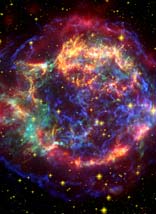|
Introduction:
The Computational Stellar Astrophysics (CSA) group uses numerical models to study:
- Coronal structure and dynamics, as well as coronal heating of other stars.
- Plasma physics in exoplanetary systems - this research involves interplanetary physics and space weather of close-in exoplanets, star-planet magnetic interaction, and magnetospheric dynamics and physics of the upper atmospheres of close-in planets.
- The corona and interplanetary environment of the young Sun.
- Radiation and ionization in accretion disks.
- Novae Hydrodynamics.
Models used by the CSA group:
- BATS-R-US - global Magnetohydrodynamic (MHD) code (U. of Michigan).
- PINTofALE - Package for Interactive Analysis of Line Emission.
- MOCASSIN - MOnte CArlo SimulationS of Ionized Nebulae.
- FLASH - global model for Hydrodynamic and MHD (U. of Chicago).
People:
Ofer Cohen, Jeremy Drake, Vinay Kashyap, Steve Saar, Cecilia Garraffo, Dai Takei.
Publications (ADS)
Here are Some Results from CSA Simulations:
Left: Star-planet Interaction in HD 189733 (click on image to see a movie). Right: A space weather CME event on a close-in exoplanet (click on image to see a movie)
Stellar coronae of young active stars (AB Doradus)
Modeling the young Sun and its solar wind
Stellar angular momentum loss rates
| 







